|

by Jenny Griffin
and Janaya Wilkins
July
2018
from
SLOActive Website
|
Jenny Griffin
Environmental Communication Consultant,
BSc (Hons)
Degree in Marine Biology,
Diploma in Nature
Conservation.
Janaya Wilkins
Marine Conservation Enthusiast,
and SLO active's
Founder. |

Plastic
Pollution - The Problem
Litter in the environment is an ongoing problem, but arguably one of
the most pressing environmental challenges that we are faced with
today is marine plastic debris.
The two common sources
marine debris originates from are:
-
land-based, which
includes litter from beach-goers, as well as debris that has
either blown into the ocean or been washed in with
stormwater runoff
-
ocean-based,
which includes garbage disposed at sea by ships and boats,
as well as fishing debris, such as plastic strapping from
bait boxes, discarded fishing line or nets, and derelict
fishing gear
While discarded fishing
gear takes its toll on the marine environment by entangling marine
life and destroying coral reefs, it only comprises an estimated 20%
of all marine debris - a staggering 80% of all marine debris stems
from land-based sources.
This is not that
surprising, considering that around 50% of all plastics are used to
manufacture sing-use items which are discarded soon after they are
first used.
How Much
Plastic is in the Ocean?
'How much plastic is in the ocean', you ask?
A study (River
Plastic Emissions to the World's Oceans) published in 2017
estimated between 1.15 to 2.41 million tonnes of plastic enters the
oceans via rivers annually, with peak months being between May and
October.
The top 20 contributing
rivers, which according to the report are mostly found in Asia,
contribute around 67% of all plastics flowing into the ocean from
rivers around the world.
The demand for plastic has increased dramatically over the last 70
years. According to Plastic Ocean, 300 million tons of plastic is
produced globally every year. Half of that plastic is used for
disposable items that will only be used once.
As a result, more than 8
million tons of discarded plastic ends up in our oceans every single
year. Once it is there it doesn't readily go away.
The Worldwatch Institute
estimates that the average American or European person typically
uses 100 kilograms of plastic every year, most of which consists of
packaging, and while it is estimated that Asians currently only use
an average of 20 kilograms per person, this is expected to rise due
to economic growth in the region.
Plastic
Pollution Facts & Figures
|
$10-20 million
Tons of plastic ends up in our oceans every year,
according to a report released by the
Worldwatch
Institute in 2015. |
$5.25 trillion
Estimated number of plastic particles currently floating
around
in world's
oceans.
|
$13 billion
Number of estimated losses per year associated with
marine plastic debris due to the negative impact
on marine
ecosystems. |
How Does
Plastic Breakdown?
One of the characteristics that make plastic so popular for use in a
wide range of industries is that it is extremely durable and
long-lasting. However, this trait also makes it persist in the
environment.
Plastics are photodegradable - meaning that they break down into
smaller and smaller pieces when exposed to sunlight.
Because the temperature
they are exposed to in the ocean is much lower than that on land,
the breakdown process takes much longer in the marine environment.
But while plastic debris is slowly breaking down in the ocean, more
and more plastic is being tossed or washed into the sea - at a rate
far faster than what it is breaking down.
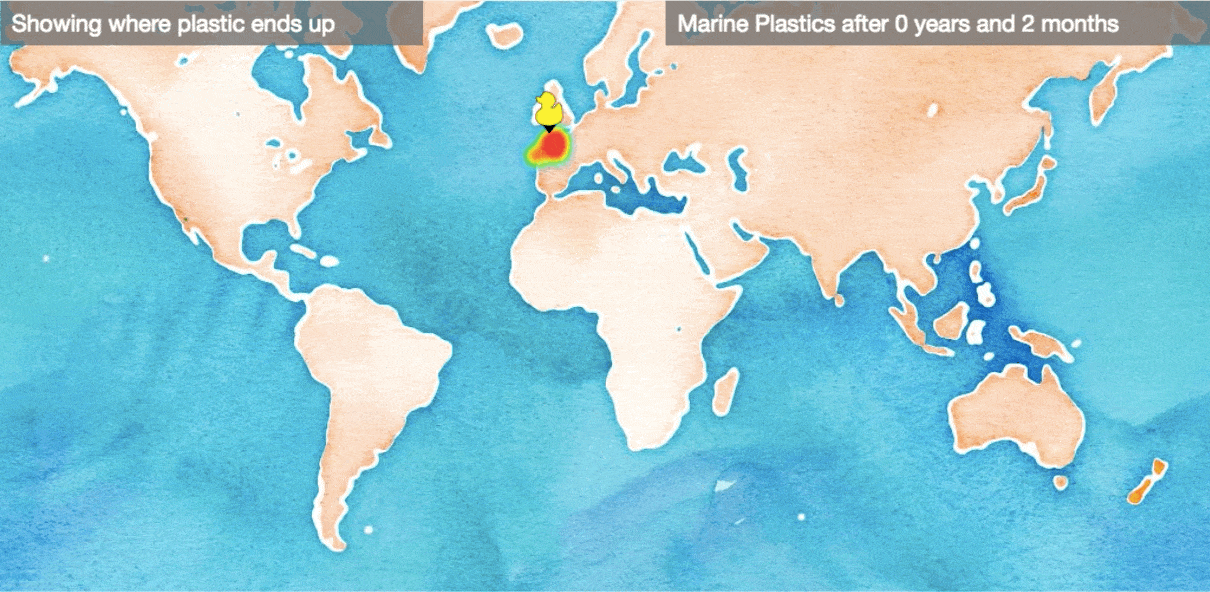
Consequently, there is a LOT of plastic in the ocean - it comes in
all shapes, forms, and sizes, and is found floating on the surface,
suspended in the water column or littering the ocean floor, and
eventually washes up on beaches around the world, wreaking havoc
with marine life in all these ecosystems.
According to a scientific report released by A Plastic Ocean, marine
plastic debris has impacted over 600 marine species from the bottom
to the top of the food chain, many dying a slow agonizing death
through entanglement or ingesting plastic.
According to Greenpeace's
report Plastic Debris in the World's Oceans:
"At least 267
different species are known to have suffered from entanglement
or ingestion of marine debris including seabirds, turtles,
seals, sea lions, whales, and fish.
The scale of
contamination of the marine environment by plastic debris is
vast. It is found floating in all the world's oceans, everywhere
from polar regions to the equator."
"If we are doubling
what we are putting into the ocean on a ten-year basis, there's
no way to keep up… It would be as if you were vacuuming your
living room, and I'm standing in the doorway with a bag of dust
and a fan.
You can constantly
keep vacuuming, but you could never catch up."
Chris Wilcox,
an
ecologist at CSIRO so aptly explains in an interview with
National Geographic.
5 Gyres - The Oceans
Garbage Patches & Microplastics Soup
Large volumes of this plastic tend to accumulate within five oceanic
'garbage patches', also known as 5 gyres, located in the Atlantic,
Indian and Pacific Oceans.
The largest of these is
the Great Pacific Garbage Patch which stretches across the
Pacific Ocean between Japan and North America, with the greatest
concentration of garbage lying in the stretch of ocean between
California and Hawaii where scientists estimate concentrations of
plastic to be around 480,000 pieces per square kilometer.
While large pieces of
plastic do accumulate in the gyre, rather than being an island of
plastic, in reality this is more like a plastic soup, consisting
mostly of tiny bits of invisible microplastic.
A 2001 survey conducted
by Captain Moore, found an average of 334,271 tiny bits of plastic
for every square kilometer surveyed.
The recovered plastic
weighed approximately six times more than plankton netted in the
same survey.
"There is no
island of plastic,
what exists is
more insidious.
What exists is a
kind of plastic smog".
Craig Leeson
Director, A
Plastic Ocean
Single Use
Plastic - the Majority of Marine Waste
Plastics and polystyrene foam (Styrofoam) comprise 90% of all marine
debris, with single use food and beverage containers being one of
the most common items found in ocean and coastal surveys.
Plastic debris in the
ocean varies greatly in size, from tiny microplastics that are
invisible to the naked eye to large pieces of plastic debris, such
as discarded fishing gear, which can extend for meters or in some
cases even kilometers.
According to the
Ocean
Conservancy's International Coastal Cleanup 2017 Report,
-
if all the
plastic bottles collected during the 2016 International
Coastal Cleanup were stacked they would have stood 372 times
higher than Dubai's towering Burj Khalifa (828 meters high)
-
all the plastic
straws collected off beaches around the world would have
stood 145 times higher than the One World Trade Center in
New York City (541 meters)
-
while all the
plastic utensils collected would have stood 82 times higher
than the Kuala Lumpur's Petronas Towers (452 meters), and
all the cigarette lighters collected would have stood 10
times higher than the Eiffel Tower in Paris (324 meters)
What are
Microplastics?
These tiny pieces of plastic, which scientists refer to as
microplastic, are now recognized as a major threat to wildlife and
to human health.
Scientific research
surveys have revealed that microplastics are widespread throughout
the world's oceans, and are having a negative impact on marine life,
as well as the health of humans who rely on seafood as a staple
protein source.
Polystyrene beads and
plastic pellets are not easily digested so tend to accumulate in the
digestive tract of marine animals who consume them.
This can result in the
animal feeling full, causing it to stop feeding, leading to
emaciation and ultimately death from starvation, or it can cause an
intestinal blockage that can also be fatal.
When a predator feeds on
a fish that has a gut full of undigested polystyrene or plastic,
this is passed on to the predator who in most cases will also have
problems digesting it.
The Health
Impact of Plastic Pollution on our Wildlife
The below photo shows all of the pieces of plastic that were removed
from the stomach of a single north fulmar, a seabird, during a
necropsy at the National Wildlife Health Lab.
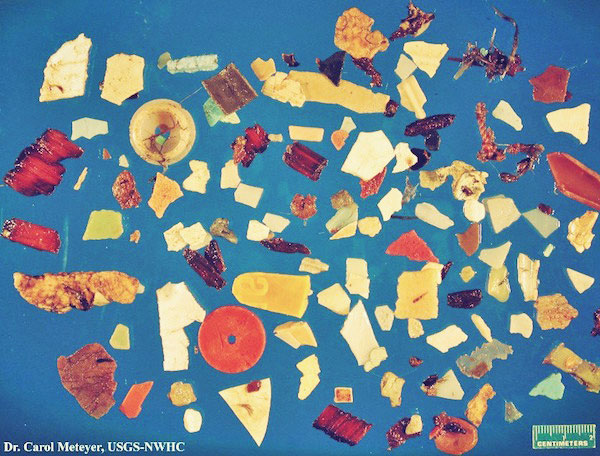
(Photo Credit: Carol Meteyer, USGS).
How does this happen?
-
Plastic packaging
is lightweight, so it is easily blown or washed into rivers
where it is carried to the sea, or it may blow directly into
the sea if not safely stowed by beach users
-
Plastic breaks
down into smaller and smaller pieces, and because it readily
floats it is often mistaken for food by surface feeding
animals, including fish and seabirds
-
Marine turtles
ingest plastic bags which they mistake for jellyfish, and
small items such as gas lighters or plastic pellets in
various stages of decomposition are mistaken for food by
seabirds and marine animals
-
Seabirds have
been known to feed these plastic pellets to their chicks,
resulting in the death of the chicks, which ultimately can
cause population numbers of affected species to decrease if
fewer and fewer chicks are being successfully raised
Furthermore, plastics and
polystyrene are made up of toxic chemicals, including petroleum,
which may be released as the gastric juices try to digest it, and
are absorbed into the body tissue.
These toxins also leach
into the water column as plastics break down, contaminating filter
feeding organisms who ingest the water while feeding. But the
problems don't end there.
Plastics are known to
accumulate persistent organic pollutants (POPs), including
Polychlorinated Biphenyls (PCBs) and DDT that are known to disrupt
the endocrine system and affect development, at concentrations of a
hundred thousand to a million times greater than naturally found in
seawater.
These contaminants are
stored in the body fat and organs of animals and are passed on to
predators that feed on them, becoming more concentrated in the
tissues of organisms higher up the food chain.
|
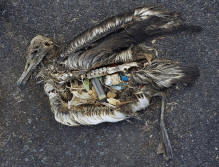
The
unaltered stomach contents of a dead albatross chick
photographed on Midway Atoll National Wildlife Refuge in
the Pacific in September 2009 include plastic marine
debris fed the chick by its parents.
(Photo Credit:
Chris Jordan/US Fish & Wildlife Services) |
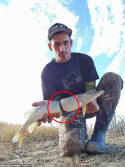
Canadian fisherman Adam Turnbull fished a pike from the
Saskatchewan River, belted with a plastic Powerade
wrapper ring. The fish most likely swam through the ring
when she was smaller and the ring has cut into her flesh
as she has grown.
(Photo Credit: Adam Turnbull)
|
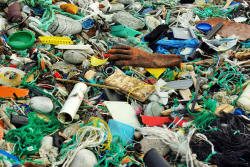
Lots
and lots of different plastic types just in this picture
of a small part of the beach. Different kinds of plastic
are predominant, a lot of it originating from shipping
and fisheries, but also from plain household garbage.
(Photo Credit: Bo Eide)
|
Long living top predators continue to accumulate more and more
toxins in their systems over time.
Studies have revealed
that marine top predators, such as killer whales and polar bears,
are amongst the most contaminated animals on Earth.
These contaminants reduce
fertility and breeding success, and compromise the affected animal's
immune system, making them more vulnerable to disease and infection.
Plastic
Microfibres
Microfibres from clothing and textiles are another key source of microplastics in our oceans. When we wash our clothes, fibres are
shed into the washing water.
Due to their minute size, these fibres
pass through wastewater treatment plants and end up in the ocean.
"Plastic Soup Foundation research team literally counted these tiny
fibres and discovered that actually up to 17 million may be released
in every wash," says Maria Westerbos, director of the Plastic Soup
Foundation, a non-profit campaign group.
Microfibres have been found in many different in many different
ecosystems, including freshwater systems, ocean waters, ocean
sediments, and beaches around the world, indicating it is a
worldwide problem that is possibly growing.
According to a report in
The Overtake,
"The International
Union for Conservation of Nature (IUCN) estimates that 35% of
all primary plastics which end up in our oceans have come from
textiles, making it the largest source of microplastics,
followed by those which come from the degradation of car tyres
(28%)."
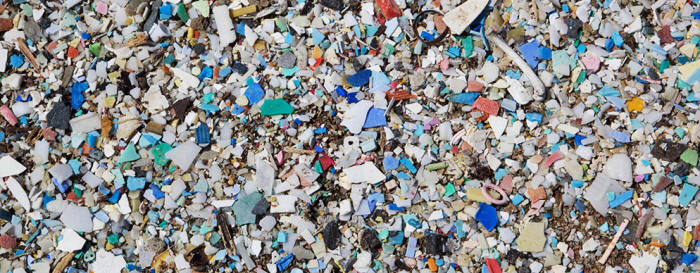
Potential
Plastic Pollution Solutions
We need to tackle the problem of marine debris head on. It's not
just an issue for environmentally conscious, it is an issue that
ultimately affects human health.
Man is a top predator
that feeds on a variety of ocean fish, shellfish and other marine
species. We face the same risks as the killer whale and polar bear.
While any plastic or
polystyrene pellets that may have been clogging the gut of the fish
that is nicely presented on our dinner plate have been long removed,
the toxic contaminants originating from that debris remain stored in
the flesh we are about to eat.
Food for thought
indeed...
Eliminating Plastic
at Source
Clearly this is a mammoth problem and one that needs to be addressed
as a matter of urgency.
The old saying
'prevention is better than cure' rings true here.
One obvious solution is
to switch from plastic and polystyrene packaging to environmentally
friendly alternatives, such as compostable plant fiber packaging
made from natural materials that readily break down in the
environment without causing any harm, and which contain no harmful
chemicals.
Many cities and countries
around the world have implemented stricter legislation with regard
to plastic shopping bags, with some
banning them outright. Perhaps
we need to do the same for plastic bottles, straws, etc.
Consumers should be
proactive and
opt for reusable and/or refillable containers rather
than disposable packaging wherever possible.
This will not only save
suppliers, and by extension shoppers, money, it will also benefit
the environment and everything that is dependent on the environment
for survival.
"Even if you don't
live near the ocean, the chances are your plastic garbage has
found its way to the sea" - Dr Sylvia Earle, Marine Biologist
and Explorer"
Single Use
Plastic Alternatives & How You Can Help
|
Reusable
Water Bottle
Avoid bottled water. Buy a decent water filter and a
reusable stainless steel bottle or a glass bottle; There
are collapsable options for the city dwellers. |
Reusable
Shopping Bag
Keep reusable shopping bags with you: in your car, work
bag, jacket pocket, and next to your front door. They're
cheap and there are foldable/pocket options. |
3 Minute
Beach Tidy
If you spend time enjoying the beach and the ocean, pay
mother nature a thank you. Make it your
pre-surf/dive/swim ritual: spend 3 mins picking up trash
from the beach. |
|
Slow Down
Stop eating on the go. Slow down and take time to enjoy
your food: eat in or take a lunchbox. Reduce your use of
disposable cutlery, plates and packaging and recycle
where possible. |
Say No To
Straws
Americans use 500 million drinking straws every day. Now
imagine how that translates to the rest of the world. If
you really love straws, carry a stainless steel one in
your bag. |
Reusable
Coffee Cups
We all love our coffee and tea, but it really takes its
toll on our environment. Carry a reusable coffee cup
with you. There are plenty of options available, from
bamboo to collapsable silicone cups to glass cups. |
Plastic
Recycling Initiatives
Because it is so tough and durable, plastic can be reused or it can
be recycled.
Popular musician and
environmental advocate, Pharrell Williams, is the
co-owner of
G-Star RAW, a
sustainable clothing brand that recently launched the
'RAW for the Oceans' collection that recycles single use plastic
containers collected from beaches all over the world into stylish
apparel.
The 'RAW for the Oceans'
fashion line has collaborated with
Bionic Yarn, another company that
Williams is both a partner and Creative Director of, which uses
recycled ocean plastics to make sustainable clothing yarn.
This creative approach
provides a sustainable resource - there is plenty of plastic in the
sea - while at the same time tackles the humungous problem of ocean
plastics by putting this practically unlimited resource to good use.
Philanthropist, environmental advocate, and entrepreneur, Richard
Branson,
has proposed that we implement a deposit refund system
for plastic bottles.
Offering an incentive for
users to return plastic bottles for recycling makes absolute sense,
especially these are one of the most prolific items found on beaches
around the world.
While reducing or eliminating plastic packaging may help to stem the
flow of plastics at the source, we still need to take steps to
prevent plastic that is already in the environment from flowing into
the ocean, and to clean up the vast amount of plastic littering
beaches around the world, as well as the plastic currently swirling
around ocean gyres.
Beach Cleanups
Every year, the Ocean Conservancy coordinates the International
Coastal Cleanup in collaboration with environmental organizations,
schools and other community initiatives around the world,
encouraging volunteers to take part in
local beach cleanups to rid
the environment of trash.
This can be stepped up at
a local level, where individuals, communities and organizations can
get more actively involved in cleaning up their local beaches to
help keep them free of plastic and other debris.

Collecting
plastic debris and water samples
from Kamilo Beach, South of Big Island Hawaii.
Kamilo Beach is approximately 1,500 feet (460 m) long
and is located on the remote southeast coast
of the Kaʻū District on the island of Hawaii.
There are no paved roads to the beach.
(Photo Credit: Cesar Harada)
Ocean Cleanup
Innovations
Some innovative individuals have proposed other solutions for
removing plastic from our oceans, including deploying
large floating
booms to trap and catch plastic designed by a Dutch entrepreneur
when he was still a teenager, and
floating sea bins designed by two
surfers that can be used to remove plastic from harbors, for
example.
While these are all indeed innovative and creative solutions to an
ever growing problem, they will in all likelihood not be enough to
stem the tide of plastic entering and swirling around our oceans.
Nor do they address the
problem of microplastics and tiny plastic microbeads that are now
having a large impact. A committed multi-pronged approach is
urgently needed.
We need to take action
now.
List of
Plastic Pollution Charities
Who else is taking
action?
References
-
CSIRO -
Marine debris: Sources, distribution and fate of plastic
and other refuse - and its impact on ocean and coastal
wildlife.
-
Eric
Dewailly, Albert Nantel, Jean-P. Weber, and Francois Meyer -
High levels of PCBs in breast milk of Inuit women from
Arctic Quebec -
Bull. Environ. Contam. Toxicol. (1989)
43:641-646
-
Christopher
Green and Susan Jobling - A Plastic Ocean: The Science behind
the Film.
-
Greenpeace
-
Plastic Debris in the World's
Oceans
-
Laurent CM
Lebreton, Joost van der Zwet, Jan-Willem Damsteeg, Boyan
Slat, Anthony Andrady & Julia Reisser - River plastics
emissions to the world's oceans - Nature Communications
8, Article number: 15611 (2017)
DOI:10.1038/ncomms15611
-
Moore, C.J.,
Moore, S.L., Leecaster, M.K., and Weisberg, S.B. - A
Comparison of Plastic and Plankton in the North Pacific
Central Gyre - Marine Pollution Bulletin 42,
1297-1300. (2001) DOI:10.1016/S0025-326X(01)00114-X
-
Ocean
Conservancy -
International Coastal Cleanup 2017 Report.
-
Viola
Pavlova, Jacob Nabe-Nielsen, Rune Dietz, Christian Sonne,
Volker Grimm - Allee effect in polar bears: a potential
consequence of polychlorinated biphenyl contamination -
Proc. R. Soc. B; 30 November 2016;
DOI: 10.1098/rspb.2016.1883.
-
UNEP (2016)
Marine plastic debris and microplastics - Global lessons and
research to inspire action and guide policy change - Nairobi,
Kenya: United Nations Environment Program.
-
Van
Franeker, J.A. and Law, K.L. (2015) - 'Seabirds, gyres and
global trends in plastic pollution' - Environmental
Pollution, 203, pp. 89-96.
-
Worldwatch
Institute -
Global Plastic Production Rises, Recycling Lags (2015)
-
Wright, S.L.,
Thompson, R.C. and Galloway, T.S. (2013b) - 'The physical
impacts of microplastics on marine organisms: a review' - Environmental Pollution, 178, pp. 483-492.
| 








